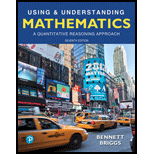
Redistricting and House Elections. The 2010 census led to the loss of two House seats in New York and Ohio. the loss of House seat in Pennsylvania. the gain of two House seats in Florida, and the gain of four House seats in Texas. Consider the following approximate vote counts for all House districts in these states in 2010 (before redistricting) and 2012 (after redistricting). All figures are in
thousands of votes. Votes for other parties are neglected.
a. Find the percentages of votes cast for Republican and Democratic House candidates in 2010 and 2012.
b. Find the percentages of House seats that were won by Republican and Democratic candidates in 2010 and 2012.
c. Explain whether the distributions of votes reflect the distributions of House seats.
d. Discuss whether redistricting based on the 2010 census affected the distributions of votes and representatives.
15. Texas
| Votes for Republican Candidates (1000s) |
Votes for Democratic Candidates (1000s) |
Republican Seats |
Democratic Seats |
|
| 2010 | 3058 | 1450 | 23 | 9 |
| 2012 | 4429 | 2950 | 24 | 12 |
Want to see the full answer?
Check out a sample textbook solution
Chapter 12 Solutions
USING AND UNDERSTANDING MATHEMATICS W/
- How many quadrillion BTU were generated using renewable energy sources?arrow_forwardThe final answer is 8/π(sinx) + 8/3π(sin 3x)+ 8/5π(sin5x)....arrow_forwardKeity x२ 1. (i) Identify which of the following subsets of R2 are open and which are not. (a) A = (2,4) x (1, 2), (b) B = (2,4) x {1,2}, (c) C = (2,4) x R. Provide a sketch and a brief explanation to each of your answers. [6 Marks] (ii) Give an example of a bounded set in R2 which is not open. [2 Marks] (iii) Give an example of an open set in R2 which is not bounded. [2 Marksarrow_forward
 Functions and Change: A Modeling Approach to Coll...AlgebraISBN:9781337111348Author:Bruce Crauder, Benny Evans, Alan NoellPublisher:Cengage Learning
Functions and Change: A Modeling Approach to Coll...AlgebraISBN:9781337111348Author:Bruce Crauder, Benny Evans, Alan NoellPublisher:Cengage Learning Holt Mcdougal Larson Pre-algebra: Student Edition...AlgebraISBN:9780547587776Author:HOLT MCDOUGALPublisher:HOLT MCDOUGAL
Holt Mcdougal Larson Pre-algebra: Student Edition...AlgebraISBN:9780547587776Author:HOLT MCDOUGALPublisher:HOLT MCDOUGAL Glencoe Algebra 1, Student Edition, 9780079039897...AlgebraISBN:9780079039897Author:CarterPublisher:McGraw Hill
Glencoe Algebra 1, Student Edition, 9780079039897...AlgebraISBN:9780079039897Author:CarterPublisher:McGraw Hill


